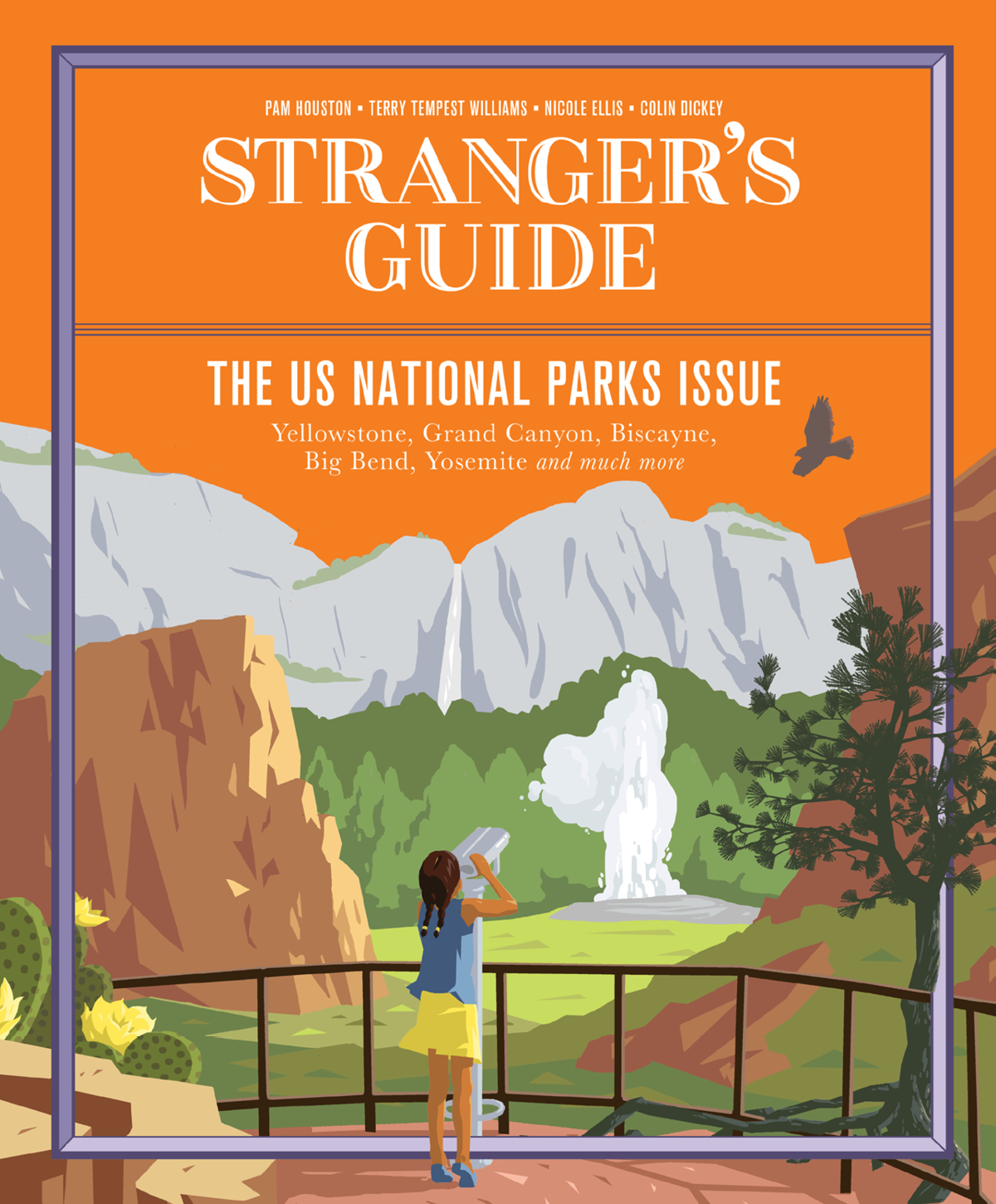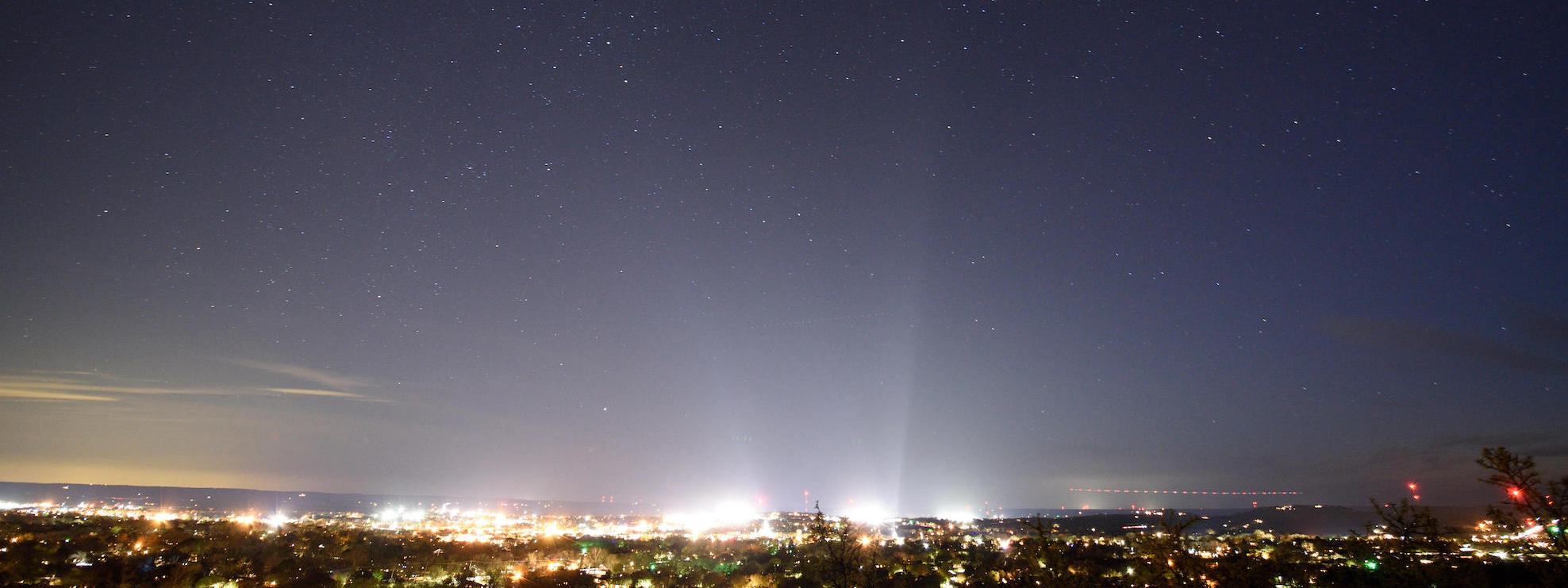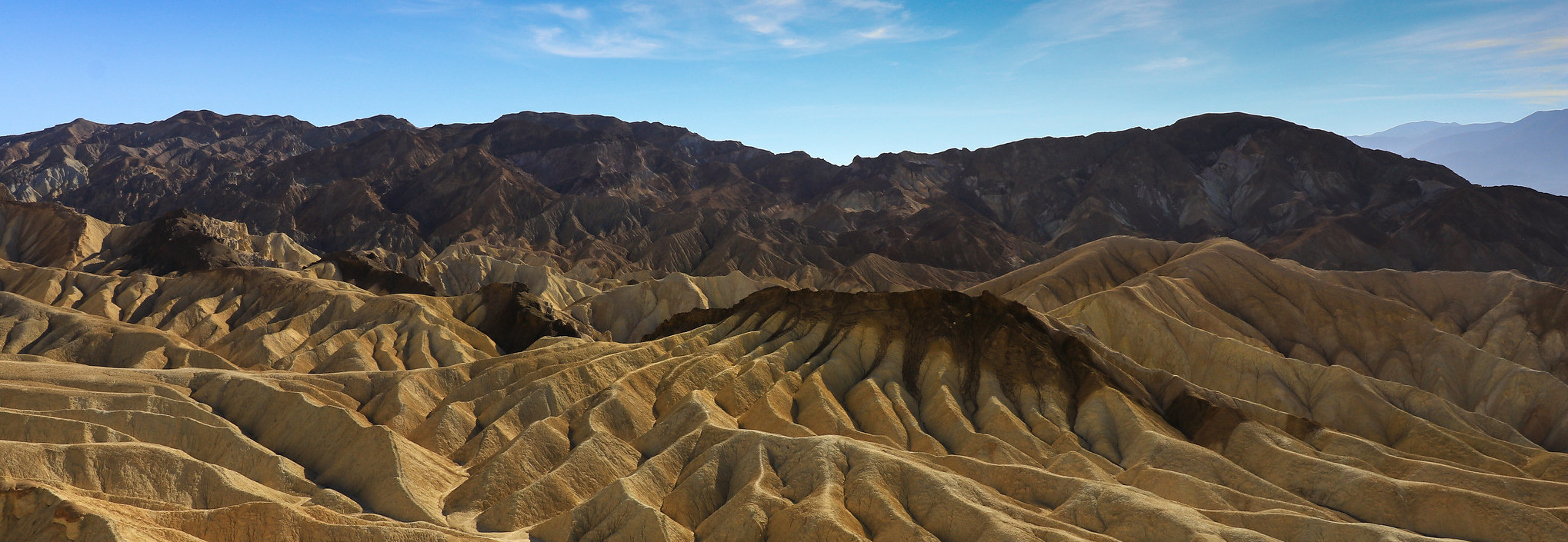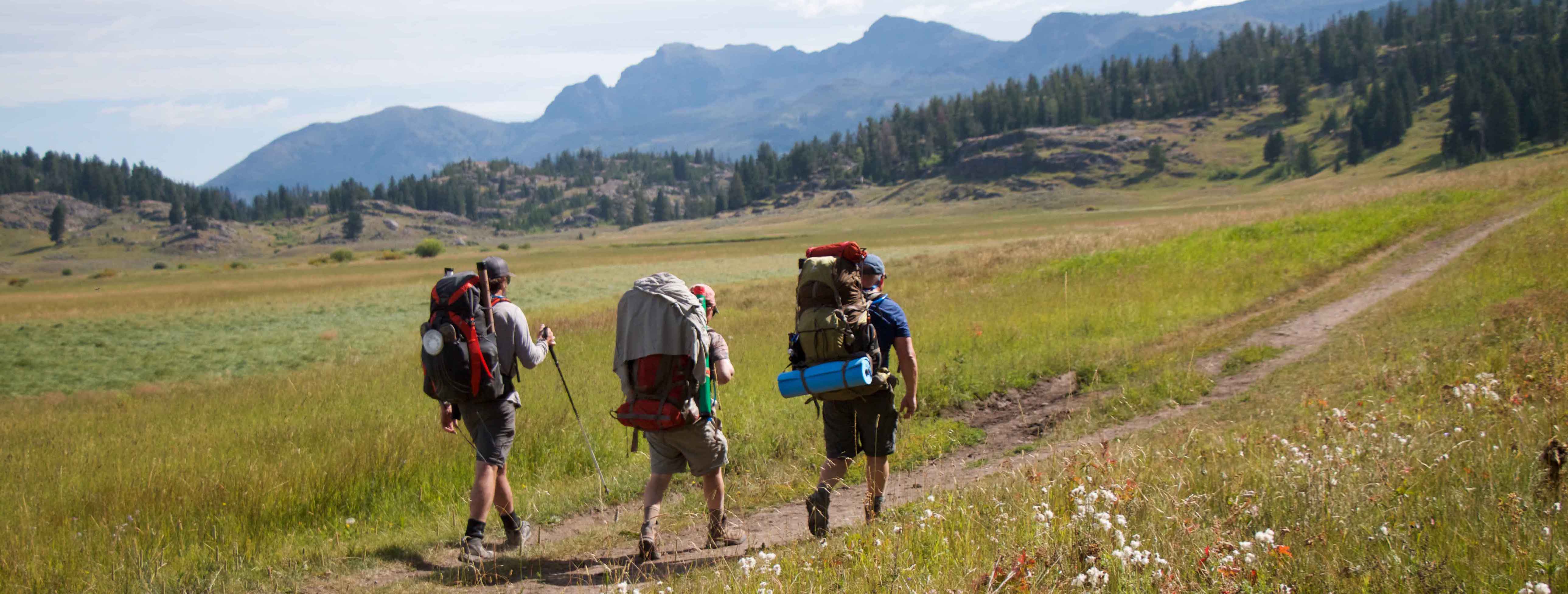
Among the ways a border is powerless is in staving off the wild spread of fire. On May 21, 2019, a blaze ignited in the remote town of Santa Elena, Mexico, just across the Rio Grande from the historic district of Castolon in Big Bend National Park. It incinerated everything in its path.
The Big Bend had gone through a wet winter, which ushered in a spring superbloom. This part of the semi-arid Chihuahuan Desert, normally yellow and erosive, was quickly scattered with wildflowers. Texas bluebonnets lined the dirt path that forked from the paved one and led to Castolon. The Indian paintbrushes, dizzying swatches of crimson, swayed on either side of the Rio Grande—the US-Mexico border—looking like families waving to loved ones. The prickly pear cacti were transformed, too, bearing flowers that were pale pink, yellow and paper-thin.
The invasive buffelgrass, an African native introduced to Texas during the 1940s to combat overgrazed rangelands and to give the cattle something to eat, shot up in fistfuls, creeping around the perimeter of Castolon’s buildings, among them the historic latrine and former army barracks, now home to La Harmonia Store and the Castolon Visitor Center. The buffelgrass had been a concern for some time, along with the cane and saltcedar, two other species brought in to address resource depletion and that had, in effect, become problems themselves.
Buffelgrass, in particular, posed a fire hazard; it burned bigger, faster and hotter than native desert vegetation. Fire didn’t stop it, either. After a burn, the buffelgrass spread, continuing to choke out native species. Due to federal funding cuts and understaffing, the buffelgrass issue—once a priority for the park—had since been tabled.
Weeks after the bloom, a stretch of hot, rainless days turned the flowers into fuel. The grasses became tinder that surrounded the town’s historic structures, as combustible as a path of gasoline. The still mornings seemed to intensify the scorch, and by late afternoon, the temperature rose to 105 degrees Fahrenheit and above. Humidity levels didn’t surpass the single digits. Then, suddenly, the still air became a vortex of wind, carrying dust that pirouetted skyward.
The fire that started in Mexico quietly burned through the night, building intensity as it crept to the banks of the river. For a moment, it remained there, its gold light reflected on the surface of the Rio Grande, whose silty waters were low from lack of rain and decades of depletion. The river, though, proved to be no barrier to the growing fire, and on May 22, the blaze crossed the border.
• • •
For the past two decades, most people who visited Castolon and La Harmonia store were RVers and other park tourists seeking provisions, some coming off the river after a float, thirsty for a cold drink.
The store, a long, rectangular adobe, sold snacks and sundries, including a variety of park tchotchkes and memorabilia. Amid the scant provisional offerings were historical artifacts set atop shelves and cabinets; the old post office boxes remained, too—reminders of the store’s long lineage and the ideals upon which it had been founded. La Harmonia store hoped to be what its aspirational name suggested: a place where people, regardless of their background, could come together in commerce.
And that’s what it was, before 9/11 became the catalyst for turning the US-Mexico border into a frontline of the so-called War on Terror. The store had a history of serving both sides, and at one point, it was a critical resource for all those who lived in the Big Bend region. Some patrons got to it by crossing the river in a ferry captained by a man who charged a dollar to get you to the other side. After 2001, all that changed. The border was closed, and residents of Mexico, who had crossed freely for generations, were prohibited passage across.
The human history of the Big Bend has long been tied to the Rio Grande, its most critical natural resource. The town of Castolon sits near Santa Elena Canyon, the most stunning gorge in the Big Bend. To float this section of the river in a kayak or canoe is to be reminded of its relevance to the region. Prehistoric-looking turkey vultures settle onto branches on either shore, all part of the same kettle. Cliff swallows build gourd-shaped nests out of the muddy banks, pinching the earth with their beaks and spitting it back out in sticky pellets in the bare, cavernous space beneath each bluff.
The border was closed, and residents of Mexico, who had crossed freely for generations, were prohibited passage across.
Early people inhabited the Rio Grande Valley and the foothills of the Chisos Mountains, which were replete with natural springs. The Rio Grande and its tributaries were this desert’s lifeline, and the first humans who roamed here did not stray far from their paths. The waters, then abundant and unchoked by cane, were an invaluable resource and a place for commerce and crossing. By the eighteenth century, nomadic tribes, including the Comanche and Apache, had supplanted the sedentary Chizo.
The first Europeans in the region arrived in the mid-sixteenth century and began to settle there, bringing with them agricultural techniques that altered the land and signaled the beginning of an enduring legacy of resource depletion and mismanagement.
The Big Bend became a part of the United States after the Mexican-American War ended in 1848. Under the Treaty of Guadalupe Hidalgo, the United States forcibly acquired nearly half of Mexico’s territory and assumed responsibility for protecting the border and all its crossings. In the following years, ranchers attempted to establish operations in the region, often hindered by an unforgiving land.
Between 1910 and 1920, the borderlands were on the frontlines of the Mexican Revolution, and during that time, the United States Department of War positioned temporary troops along the border to mitigate bandit raids. The fiercest of these incursions often occurred in the least-populated regions—areas like the Big Bend—where the small population and troop presence allowed for an easier getaway and the rough, undulating terrain supplied ample cover.
One officer, 19 cavalrymen and 20 infantrymen were stationed in the Castolon region, then known as Santa Helena. They were concerned with the likes of Chico Cano and his gang, who orchestrated a series of major raids in the region. But apart from the occasional chase, Uncle Sam’s men had ample time to spare. A hundred miles from the nearest railroad and even farther from major city centers, they had little in the way of diversion, apart from swimming in the shallow parts of the river and playing pickup games of football.
The soldiers’ commanding general became concerned with the morale of the group when five of the men snuck over to Mexico. So-called morale officers were assigned to combat the issue, and they facilitated movie screenings twice a week and supplied the men with books and magazines—an attempt to prevent more border crossings. Because they were there temporarily, the men were forced to sleep in tents or under the stars.
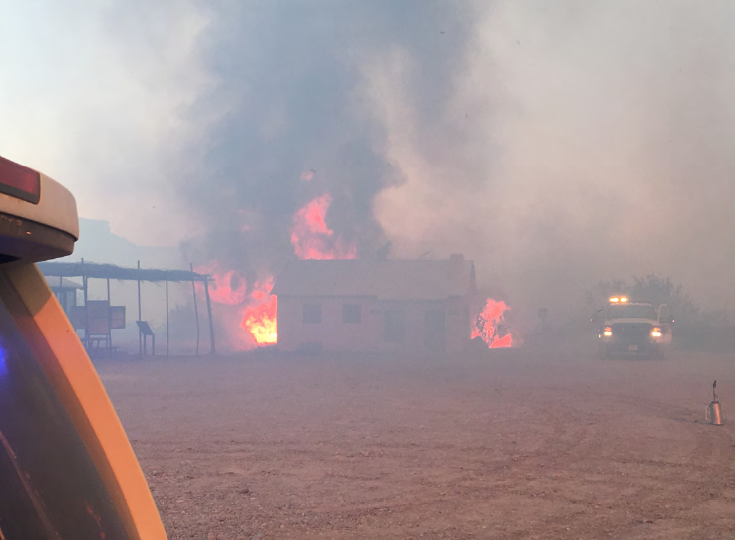
Responding to an increase in raids in 1916 and 1917, the United States Department of War decided to convert the temporary outposts into permanent stations where more troops could be introduced to the region. The government leased land at Castolon from local entrepreneurs Howard Perry, who owned the Chisos Mining Company, and Wayne Cartledge, who operated a cotton production company. By 1920, the stations, built out of adobe bricks and plastered with stucco, were complete: one barracks building, buildings for officers and noncommissioned officers, as well as a barn and corral.
“The new camp will be ready for occupancy this month,” Morale Officer Lieutenant Reinhardt reported in August 1920. “The men are anxiously awaiting this as they have been living in tents the last 10 months.”
Before they could move in, however, the Mexican Revolution and its decade of unrest had subsided. Over time, the troops were withdrawn and the compound was abandoned. Cartledge purchased the buildings and, responding to the demand created by the hundreds of laborers working in the nearby mines, opened La Harmonia store in the army barracks.
La Harmonia grew to be a store for all and sold most anything you could imagine. Peddlers sold furs, skins and hides, stacked in tall piles that reeked of barnyards and decay. For his many Mexican patrons, Cartledge stocked the store with blankets, glassware and clay pottery from their native land.
The shelves were lined with staples like sugar, coffee, beans, sardines and cheese, as well as topical medical supplies. The store sold clothes, too: wide-brimmed hats, work shoes and shirts, lace ribbon and dresses, and the occasional men’s suit. In hardware, the store provided pocket knives, barbed wire, plows, harnesses and saddles. What La Harmonia didn’t have in stock, Cartledge made sure to procure, once filling an order for bridal wreaths and veils.
La Harmonia grew to be a store for all and sold most anything you could imagine.
In 1935, a bill was put forth to preserve the Big Bend country as a national park. Over the next decade, the US government spearheaded the laborious process of acquiring privately owned lands, to the great chagrin of steadfast landowners who had sacrificed so much to make it work. Cartledge kept La Harmonia until 1961, when he finally sold it to the park. A lasting symbol of hope, the name was kept alive.
• • •
On the Texas banks of the Rio Grande, the invasive cane and salt cedar—green and pliant—burned like stakes in a fire. From the river’s floodplains, the fire crept up into the dense thicket, where mesquite and creosote bushes exploded upon contact with the rising flames. Turkey vultures circled overhead, cruising on thermals.
The flames proceeded to the mesa, upon which the Castolon Historic District had been built, and tore into the buffelgrass that snaked to the backside of the latrine. And then the winds shifted. They blasted into the fire, sparks shooting out from within its core. The small town was ablaze. The attic ventilation system of La Harmonia created a chimney effect that turned the building into a furnace.
Inside, the store’s supplies were incinerated. Beer boiled in cans. A glass butter churn that once belonged to former resident Magdalena Silvas melted into a molten pool, its metal crank twisted and warped. Cash registers that served the original store were destroyed, too, their keys dissolved beyond recognition. The fire consumed the attic’s wooden framing, and the roof collapsed.

Thanks to the United States’ closed border policies, barring fire or emergency, the firefighters are otherwise not permitted to work in the park—not even to help trim the buffelgrass. And, until a couple of years ago, they were not permitted to cross at all without an American escort.
Along with the Terlingua fire department and EMS, Los Diablos doused the blaze with thousands of gallons of water, able to save all but the latrine and store, of which all that seemed to remain were charred adobe walls. The ramada and porch, as well as all doors and windows, were lost.
Days later, as the fire continued to burn on both sides of the river, now diverted from the historic district, park archeologists sifted through the debris, uncovering artifacts that survived the burn: two cast iron stoves, the old post office doors, an iron once used by Magdalena Silvas, a collection of doorknobs and brackets.
On June 1, the fire was 100 percent contained; its total damage spanned 944 acres—797 in the United States and 147 in Mexico. The longer days brought triple-digit temperatures. High winds diffused Castolon’s charred remains like scattered ashes.
The National Park Service reviewed the damage and determined that the structures were unsalvageable and should be demolished. David Keller, though, an archeologist at the Center for Big Bend Studies, concluded that both the latrine and barracks could be restored. The Big Bend Conservancy, a nonprofit committed to promoting and supporting Big Bend National Park and its initiatives, led a fundraiser to help cover the cost of the repair. There was still hope.
Amid the ruins, park archeologists discovered another artifact: La Harmonia’s original sign. It had once hung above the store’s door, greeting the region’s diverse patrons as they entered the warm and welcoming space that long ago had promised harmony.
Contributor
Sasha von Oldershausen is an Iranian-American writer and journalist, who writes about immigration and diaspora. Her work has appeared in the New York Times, the Atlantic, Harper’s and the Paris Review.

